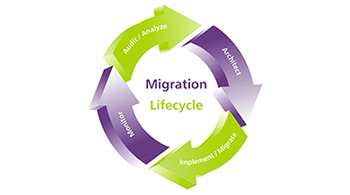10 Factors needed for a successful Migration Strategy
As companies learn and evolve into faster & more productive organisations, they realise that upgrading their legacy applications is the first thing to do. Migrating legacy applications is an efficient way to build on a system that’s been created and customised for many years. However, the process can seem tedious for many companies.

To begin with, you can divide the entire process into a few different parts. Here’s an example:
Pre-migration stage
1. Viability: It is essential to understand your current application first before trying to migrate. It is also important to have a critical understanding of the end users’ expectation. You can have trained staff & personnel for the same purpose. Also, you will have to look at hardware & software requirements like memory, scalability, disk capacity, software licenses, etc.
2. Risk Assessment: Many organisations migrate to Cloud or other platforms because of the efficiency. However, the risks for every organisation will be different. It is important to have a complete endorsement from the management.
Also, some migration tools do not support legacy operating systems.
Tip: Try setting milestones in your entire migration plan. This will be highly effective if you have an outside vendor providing you with the services as you can make payments based on the achievements.
3. Partner-up with a qualified migration & project manager team/staff: A qualified partner can mean a world of difference when it comes to creating a migration strategy. A qualified partner can provide you with the right staff, expertise, time, etc.
During Migration
4. Integrate Change Control Process: Change control is a systematic approach to managing all changes made to a product or system. This ensures that no unnecessary changes are made.
5. Right Project Path: Whether you’re looking to figure out the right migration or upgrade path, determining it right now is of paramount importance.
6. Automatic/Manual tools: The automated tools work on a ‘one-size-fits-all’ system during migration. They help in converting the code to better versions or frameworks or brings the entire date/infrastructure to the target environment.
Sometimes, however, automated tools do not cover the entire spectrum, which is why the task has to be done manually as well.
7. Document every procedure: It is important to document every migration stage. This will provide you with a better insight and clarity on each stage.
8. Prepare a test strategy: As you progress towards completion, you must focus your attention towards creating a testing strategy. This will ensure that the users have some familiarity.
Post-completion
9. Testing Phase: Testing is paramount to ensure the results have been satisfactory and also weed out any issues. To ensure that testing will show the same results in both environments, you can set up a duplicate environment.
Here are the different levels of testing that must be done to ensure a smooth migration process
Performance Testing
Load stress testing
Specific Pre-Upgrade and Post-Upgrade Tests
10. Training & Support: Proper training of operational and technical support staff is crucial to the success of your migration project. Along with supplying training resources and manuals, it’s also extremely important to provide troubleshooting options and data on interoperability.



